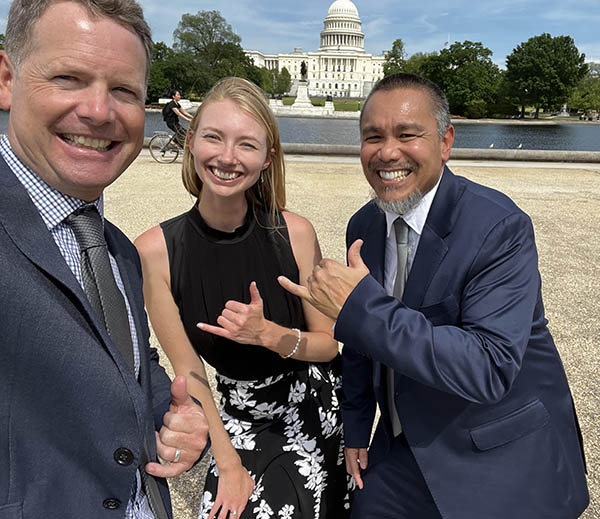7/9/24 – DAR in DC
This past May, representatives from the Hawaiʻi Division of Aquatic Resources participated in the 49th U.S. Coral Reef Task Force Meeting in Silver Spring, Maryland.
What is the U.S. Coral Reef Task Force?
The United States Coral Reef Task Force (USCRTF) was established in 1998 by Presidential Executive Order (EO13089) to lead U.S. efforts to preserve and protect coral reef ecosystems. The USCRTF includes leaders of 15 different federal agencies, 7 U.S. States and Territories, and 3 freely associated states. The USCRTF helps build partnerships, strategies, and support for on-the-ground action to conserve coral reefs. The State of Hawaiʻi Division of Aquatic Resources (DAR) participates in the USCRTF to share challenges and opportunities with Federal partners and the other U.S. Coral Reef Jurisdictions to support coral reef management efforts in Hawaiʻi.

The seven U.S. Coral jurisdictions: The Commonwealth of the Northern Mariana Islands (CNMI), Guam, Hawaiʻi, American Samoa, Florida, Puerto Rico, and the U.S. Virgin Islands
Advocating for Hawaiʻi
This spring, DAR attended the 49th USCRTF meeting and met with Federal partners to discuss topics spanning from coral disease, bleaching, watersheds, enforcement, and new federal legislation. Participating in these meetings serve as an important avenue to bring up challenges and needs related to coral reef management occurring in Hawaiʻi on a national scale. In addition, DAR can advocate for coral reef management needs that require cross-agency collaborations with Federal partners.

Dr. Ryan Okano (DLNR) presents on the extent of the invasive soft coral Unomia sp. found in Pearl Harbor to co-chairs of the USCRTF, Nicole LeBouef (U.S. Dept of Commerce) and Carmen Cantor (U.S. Dept. of Interior). This invasive species requires federal collaborations with the Department of Defense, as Pearl Harbor is a restricted area in the State.
This is also an opportunity to ensure that federal policies to manage coral reefs appropriately represent the State’s unique ecological, cultural and social needs. This USCRTF meeting was of particular importance because of the recently passed U.S. Coral Reef Reauthorization Act. This act establishes new funding mechanisms, new management criteria, and new compliance measures that affect all States and Territories across the United States. Therefore, it was an important time to have in-depth conversations with Federal agencies such as the National Oceanic and Atmospheric Administration (NOAA) Coral Reef Conservation Program and the Department of Interior on best ways to implement new requirements from the Act that align with Hawaiʻi needs.
Cross-jurisdiction knowledge sharing
During the USCRTF meeting, DAR also met with members of the U.S. All Islands Coral Reef Committee. This is a peer-to-peer exchange between U.S. Coral reef jurisdictions that supports cross-jurisdiction learning between the Caribbean and Pacific basins. During this meeting, the All Islands Committee discussed innovative reef monitoring technology from the National Aeronautics and Space Administration (NASA), support for water quality management from the Environmental Protection Agency (EPA), and funding opportunities from Federal partners.

DAR staff Brian Neilson, Lara Noren, and Ryan Okano after visits with congressional staff to discuss coral reef management challenges and opportunities in Hawaiʻi.
DAR on the Hill
In addition to the USCRTF, DAR also paid a visit to congressional staff representing Hawaiʻi in the U.S. Senate and the U.S. House of Representatives. DAR staff met face to face with elected officials and their staff to hear about priorities from Congress as it relates to aquatic resource management. Congressional staff also heard updates on issues occurring in the State of particular importance to constituents, a meaningful opportunity for DAR to collaborate with Congress for the people of Hawaiʻi.
To learn more about federal programs discussed in this blog post:
- The U.S. Coral Reef Task Force: https://www.coralreef.gov/
- The U.S. All Islands Coral Reef Committee: https://allislandscommittee.wordpress.com/aic/
- NOAA Coral Reef Conservation Program: https://coralreef.noaa.gov/
- The Coral Reef Conservation Reauthorization Act: https://uscode.house.gov/view.xhtml?path=/prelim@title16/chapter83&edition=prelim
- Presidential Executive Order (EO13089)
